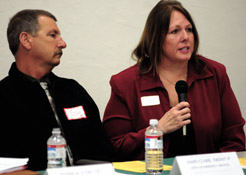
Emergency resources personnel from San Benito County gathered Thursday morning for a four-hour workshop to discuss how sharing information with community members might play out in a serious emergency situation – including notes on the benefits and pitfalls of social media, needs of traditional media outlets and what role different agencies might have in an emergency.
Working with Jim Clark, the San Benito County Emergency Services Manager, two consultants presented two seminars and then talked participants through a scenario of a potential emergency to open the dialogue about how they would respond. Paul Penn and Mike Spicer, of EnMagine, Inc., focused the scenario on public information.
“In a disaster, the size of the psychological footprint greatly exceeds the medical footprint,” Penn said, quoting a study. “We’ve got to be able to get out as much info out as we can without compromising the investigation.”
The workshop included members of local law enforcement and emergency personnel, county and city workers that may be involved, a representative from American Red Cross and members of media outlets. Before starting the seminar, Penn asked participants to introduce themselves, share what their role would be in an emergency and anything that scares them about public information. The general consensus seemed to be concerns about getting inaccurate information to the public.
“Just issuing a release doesn’t cut it anymore,” Penn said.
He stressed the mission of public information as getting the right information to the right people in the right format at the right time so they can make the right decision.
Penn also shared some tips for people who find themselves in the role of a public information officer in a disaster:
• Express empathy
• Confirm the facts of where, when, what, who, why and how and action steps that are being taken
• Say what you don’t know
• Tell what process will be used to get answers
• Give people action steps
• Tell them where and when they can get further information
“Mixed messages distract from the real message you are trying to get out,” Penn said, noting that with social media the spread of inaccurate information or rumors can move rapidly. “You need to jump on it and address it immediately or you will be putting all your efforts into countering a rumor.”
Penn also said a good public information plan will understand the target audience, which may mean finding ways to disseminate information in different forms for different groups, such as those without access to the Internet or who don’t speak English fluently.
In the scenario presented for the workshop, Spicer, Clark and Penn devised a hypothetical situation where a group of rival drug dealers get into a brawl at a local bar in downtown Hollister. In their scenario, a gun is fired and the fight is taken to the street into the Wednesday afternoon farmer’s market where civilians are gathered. Spicer and Penn said they had come up with the scenario before the Aurora and Sandy Hook shootings occurred.
Spicer explained the Department of Homeland Security definition of an active shooter as “an individual who uses a firearm who is engaged in a confined area with no pattern or method to their selection of victims.”
The scenario allowed an open dialogue between agencies about how they would respond in the situation and what challenges might come up.
In the scenario, which used a time of 5:15 p.m. on a Wednesday, the sheriff’s department and Hollister Police Department both would be short staffed as some officers leave at 5 p.m. Other departments also noted that with a 5 p.m. closing time, many involved might be out of the office already. Penn had the participants brain storm other agencies that might have a sworn officer, such as the fire departments or state parks. They talked about how emergency personnel would be called in, the role of mental health and other social agencies, as well as how quickly information about the incidents would get out.
Most people agreed text, twitter and other social media sites would be used to circulate information almost immediately.
Penn suggested the local emergency plan include instructions to immediately implement a public information officer coordinator rather than waiting several hours after the incident. He also suggested the creation of a joint information center during emergencies so multiple agencies or jurisdictions can work together to put out a consistent message.
“People just want to know ‘Am I okay? Will I be okay? Will the people I care about be okay? And what do we do?’” Penn said.
At the end of the workshop, Clark said he thought the discussion was helpful for the agencies that would be involved. He noted that workshops and drills are some of the only ways local agencies are able to practice the emergency management plan because San Benito County does not have many large-scale emergencies as a more urban community might have.









